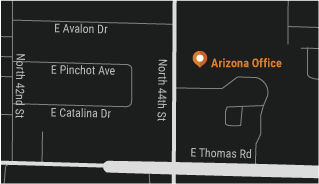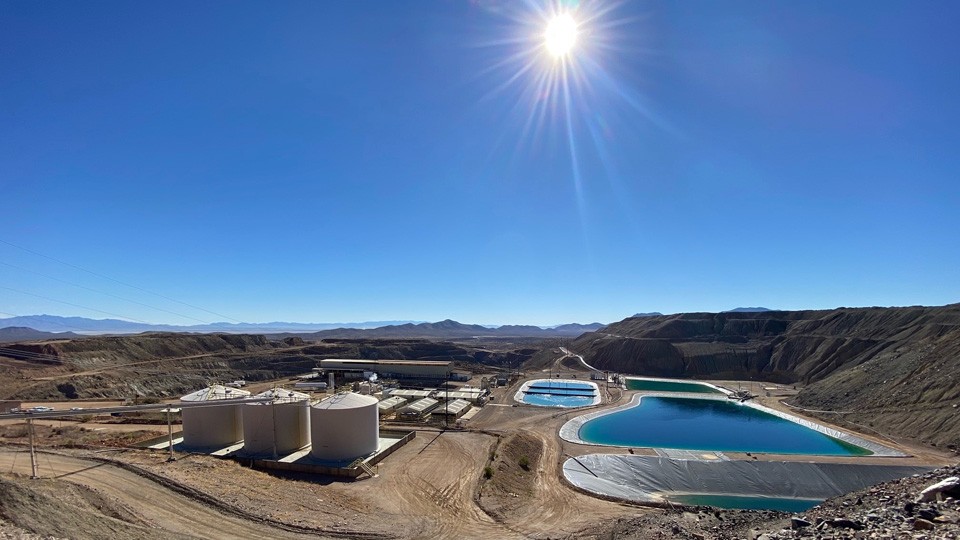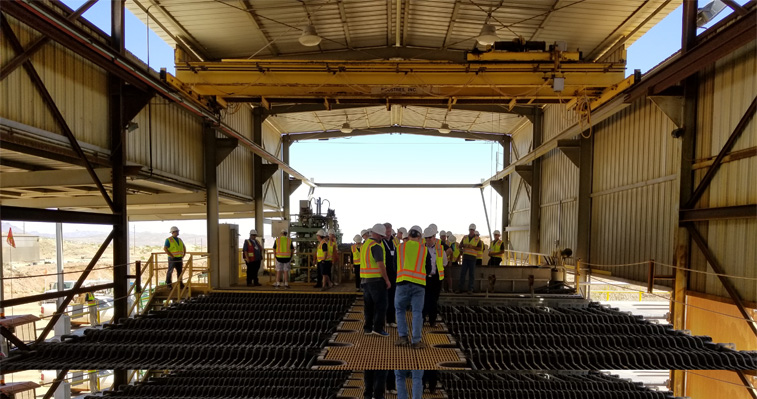Opportunities
Several opportunities have been identified which could enhance the viability and economic attractiveness of the Open Pit Project. Many of these opportunities may be realized by removal of risk and uncertainty that are present at the PEA level.
- Acid Consumption. Mineralized material sorting is a significant value-add opportunity for the Gunnison open pit. Greater than 80% of the mined copper is oxide mineralization, forming visually distinct blue-green and red-brown zones that are ideally suited to optical mineralized material sorting. Preliminary data suggest sorting of this material has the potential to greatly reduce acid consumption and volume of material leached by removing 40 to 50 percent of the process stream as unmineralized, higher acid consuming, waste. This would result in significant savings on operating costs.
- Pit Slope Angles. The pit wall angles for the Gunnison open pit are considered reasonable based on the data available, however it is conceivable that pre-feasibility geotechnical data can steepen the pit walls in the gravel-alluvium, thus reducing pre-strip capital costs and life of mine waste mining costs.
- Copper Recoveries. The anticipated copper recovery is an estimate based on the best interpretation of existing test work. This copper recovery could be exceeded in practice. Recovery increases could improve the rate of recovery, as well as increase total copper recovered. Improvements in the rate of recovery would mean lower flows from the leach pad for the same level of copper production, lowering operational costs., Or, the increased grade could result in higher copper production (revenue) for the same operating cost. Improvements in total copper recovered have the obvious benefit of increasing total revenue during the life of the mine.
- Increased Copper Price. The current financial analysis is based on an average, long-term copper price of $4.10 per pound based on current consensus pricing. Current spot markets are currently 5% to 10% higher than long-term pricing estimates. Global demand increases for copper have the potential to drive copper prices higher, thereby increasing the economic (revenue) outlook for the Project.
- Strong and Harris Copper-Zinc-Silver Project. The Company filed a separate technical report dated October 20, 2021, on the Strong and Harris Copper-Zinc-Silver Project titled “Estimated Mineral Resources and Preliminary Economic Analysis, Strong and Harris Copper-Zinc-Silver Project, Cochise County, Arizona” (the “S&H PEA”). At present, the S&H PEA contemplates development of the project on a standalone basis with its own infrastructure. JCM is also now being developed on a standalone basis in collaboration with Nuton, LLC, without sharing infrastructure with Gunnison. However, with the potential development of an open pit at Gunnison, the opportunity for shared infrastructure, capital, and operating costs with the Strong and Harris open pit is significant and may form the basis for future technical reports integrating all deposits: Gunnison, Strong and Harris and Johnson Camp Mine.
- Gravel Revenue. 759 million tons of alluvial gravel is expected to be mine during the mine life. Gravel as an aggregate or rock product is a potential source of revenue. The planned rail spur and railyard provides the Company with access to larger markets for the sale of construction aggregates. Presently, the sale of construction aggregates, is not included in the financial analysis presented in this report. However, if just 10% of this material could be sold for a net cost of $5/ton, it could potentially add $380M in revenue to the Project. This does not include the costs of making this material marketable, and there is no guarantee it can me made marketable.
- Limestone Revenue. Similar to construction aggregates, 85 million tons of clean limestone waste will be produced from the mining operations at Gunnison. Crushed limestone is highly valuable commodity in cement, aggregate, chemical and agricultural industries, selling for between $10/ton and over $60/ton in the region. Previously, the Johnson Camp-Gunnison area has been investigated as a source of limestone. With the rail spur and railyard, this material could be transported by rail to several regional markets. If 50% of this limestone waste could be sold at $20/ton it could generate approximately $850M in additional gross revenue. This does not include the costs of making this material marketable, and there is no guarantee it can me made marketable.
- Alluvium Mining. 67% of the waste mined in the pit is weakly cemented gravel (alluvium). The current design includes 40% drill and blast for this gravel however it is possible much of this material will not need any drill and blast. This will be investigated during the planned pre-feasibility study (“PFS”).
- Alternative Mining of Alluvium. The current removal of alluvium envisions the use of blast-haul operations. There are potential cost savings by developing other means of removal such as use of conveyors, dozers, or earth movers instead of blast-load-dump equipment. These will be investigated during the PFS”.
- In-pit Leaching. In-pit leaching provides an opportunity to reduce operating costs and improve leach recovery over the life of mined mineralized material. The nature of the Gunnison deposit and aquifer would allow control of leach solutions. Permitting of in-pit leaching would be required through Arizona Department of Environmental Quality, though it is currently being employed at other properties in Arizona. Production sequencing will utilize in-pit leaching as a trade-off to the construction and maintenance of a heap leach pad during PFS work on the Gunnison open pit.
- Exploration Potential. The mining district that GCC has consolidated in recent years exhibits significant exploration potential. Modern exploration activity has not occurred in the district. District-wide data consolidation and integration should be conducted to evaluate its overall mineral potential and identify exploration targets. Exploration for the source of the porphyry copper sulfide mineralization at Gunnison has never been conclusively conducted and copper skarn deposits such as Gunnison are often associated with large nearby porphyry copper deposits. Several historic carbonate replacement deposits including the Republic and Moore deposits merit additional exploration attention. Significant areas of Earp Formation, Colina Limestone and Horquilla Limestone are under cover and have not been explored. These same formations host the mineralization in the Hermosa-Taylor deposits being developed by South 32 in southern Arizona.
The Gunnison deposit is ideally suited to optical mineralized material sorting.
The oxide copper mineralization makes up over 80% of the tons mined. The mineralization is on fracture surfaces and will be exposed on surfaces during the crushing process.
Between these mineralized zones are off white colored marbles that are high in acid consumption but contain little to no copper.
Test work using an optical mineralized material sorter on Gunnison material has shown effective separation of the mineralized colors from the non-mineralized colors. The waste typically has 5 to 10 times the acid consumption as the mineralized material.
The removal of internal waste, will result in lower acid consumption and lower capital costs due to a smaller leach pad and acid plant.







